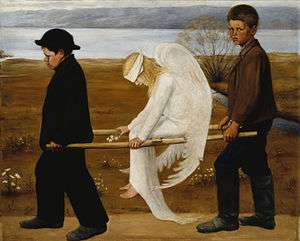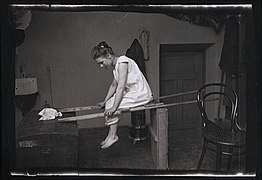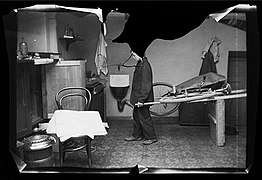The Wounded Angel
The Wounded Angel (Finnish: Haavoittunut enkeli) (1903) is a painting by Finnish symbolist painter Hugo Simberg. It is one of the most recognizable of Simberg's works, and was voted Finland's "national painting" in a vote held by the Ateneum art museum in 2006.[1][2][3][4] In a similar 2013 vote held by Nordic Moneta, it was voted second most important.[5]
| The Wounded Angel | |
|---|---|
 | |
| Artist | Hugo Simberg |
| Year | 1903 |
| Type | Oil |
| Dimensions | 127 cm × 154 cm (50 in × 61 in) |
| Location | Ateneum, Helsinki |
Like other Simberg works, the atmosphere is melancholic: the angelic central figure with her bandaged forehead and bloodied wing, the sombre clothing of her two youthful bearers. The direct gaze of the right-hand figure touches the viewer.
The procession passes through a recognisable landscape, that of Eläintarha, Helsinki, with Töölönlahti Bay in the background.[6] The same road still skirts Töölönlahti Bay today. In Hugo Simberg’s time, the park was a popular spot for leisure-time activities among the working classes. At the time, many charity institutions were located in Eläintarha park; in The Wounded Angel the healthy boys are carrying the injured girl towards the Blind Girls’ School and the Home for Cripples. She clutches a bunch of snowdrops, symbolic of healing and rebirth.
Simberg himself declined to offer any deconstruction, suggesting that the viewer draw their own conclusions. However it is known that Simberg had been suffering from meningitis, and that the painting was a source of strength during his recovery.[7] This can also be read metaphorically: meningitis is known to cause neck stiffness, lethargy and light sensitivity, each of which is exhibited by the central figure. If read as lungs rather than wings, such a diagnosis even explains the minor injury, as tubercular meningitis causes abrasions to the upper lungs.
The Wounded Angel was praised by a number of Finnish artists when first displayed in 1903 at the Ateneum autumn exhibition. In a letter to his sister Blenda, Simberg wrote on the 10th of October 1903: ”I wanted to share the good news with you – I was not rejected this year, even though the jury was terribly strict. It seems that I have achieved something of a grand succés among my colleagues and the members of the jury. Gallén is so excited that I can hardly take him seriously. His first words were the highest flattery of my work and, oddly, he seems quite beside himself with enthusiasm for the big painting. He says that it gives him the impression that I had stood alone in a little cabin, huddled in the midst of a great forest, and had painted in complete indifference to the outside world. He says that it radiates peace and harmony like no other work in the exhibition – Even Edelfelt said nice things to me.”[8]
When Simberg was asked to paint frescoes for the Tampere Cathedral in 1905–06, one was a larger version of The Wounded Angel, his favorite painting.[7]
 Study for the Wounded Angel, 1902
Study for the Wounded Angel, 1902 Another study for the Wounded Angel, 1902
Another study for the Wounded Angel, 1902 Photograph from 1902–1903 of the painting in progress
Photograph from 1902–1903 of the painting in progress
References
- "Haavoittunut enkeli voitti äänestyksen Ateneumin Maamme-taulusta". Helsingin Sanomat. 2 December 2006. Archived from the original on 24 February 2012.
- "Haavoittunut enkeli on suomalaisten suosikkitaulu". Yle. 2 December 2006. Retrieved 23 May 2020.
- "Haavoittunut enkeli, 1903". Kansallisgalleria. Retrieved 9 May 2020.
- Halonen, Kaisa (26 September 2018). "Haavoittunut enkeli on Ateneumin rakastetuin maalaus". Kirkko ja kaupunki. Retrieved 9 May 2020.
- Blencowe, Annette (5 February 2013). "Albert Edelfeltin Leikkiviä poikia rannalla äänestettiin Suomen merkittävimmäksi maalaukseksi". Retrieved 22 May 2020.
- (in Finnish) Leppänen, Marko: Maalaukseen astuminen – Haavoittunut enkeli Eläintarhassa Esoteerinen maantiede ja periferiaterapia. Accessed 16 April 2010.
- (in Finnish) The Wounded Angel at the Ateneum website
- Olavinen 2000, page 96. Hugo Simberg 1873–1917. Text by Anja Olavinen. Helsinki: Ateneum (Ateneum Publications No. 13), ISBN 951-53-2095-X
External links
